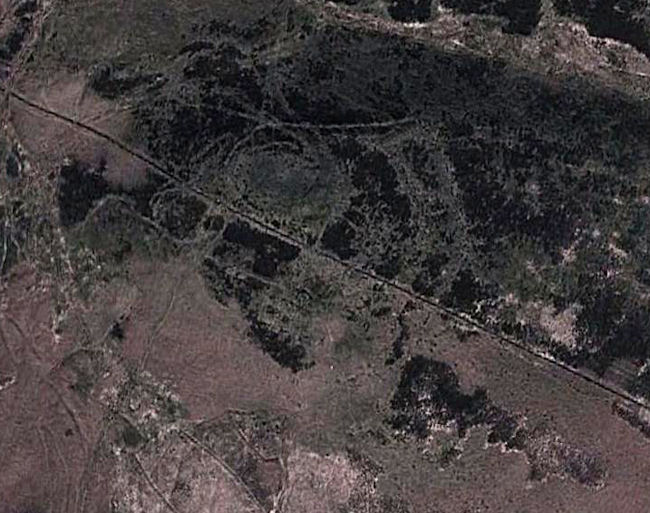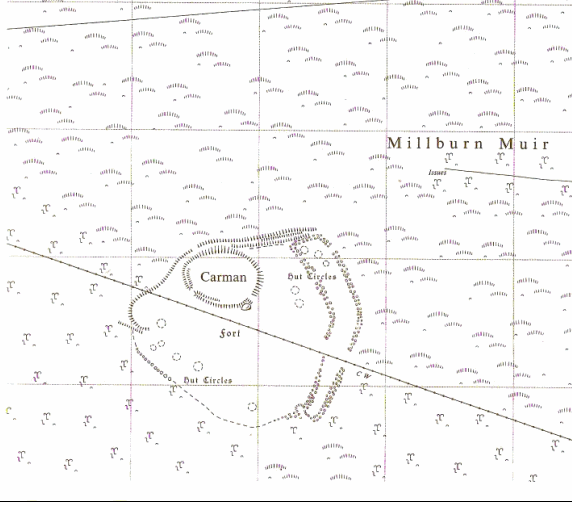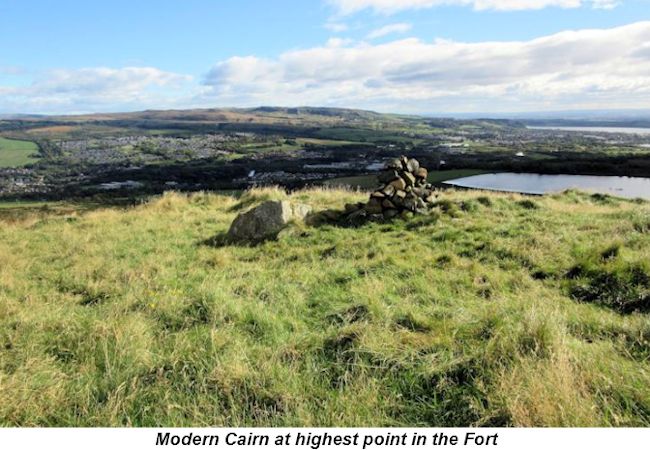Christian Camelot?
In a previous article I presented the case for the hill-fort of Carman in the Vale of Leven having been Arthur’s main power base, and therefore in a sense, his “Camelot”.
In this article I intend to examine the evidence which would suggest firstly that Arthur’s Britons were Christian, and secondly that Carman had a spiritual as well as a defensive purpose.
The mediaeval literature concerning Arthur presents him as a specifically Christian hero, but in our own time it has become fashionable for authors to claim that the early writers were either churchmen, or very much under the formidable influence of the Church and, as such, conformed to its agenda.
Equally, however, it might reasonably be suggested that these authors of the late twentieth and early twenty-first centuries are themselves guilty of conforming to a fashionable, anti-Christian (or anti-Church) cynicism when they insist that Arthur and his people were pagan.
 Carman Hill Fort
Carman Hill Fort
In a general sense it may firstly be said that Christianity became the official religion of the empire long before the Romans left “Britannia” in 410 AD. Further, it is known that a British Church was established as early as the 3rd century. Two great Christian missionaries were Britons: St Patrick (385 AD to 461 AD) and St Ninian (360 AD to 432 AD). It is to the former that we owe convincing evidence that the Britons of the Dumbarton district were Christian by Arthur’s time.
Regarding St. Patrick himself, Dr. Chris Lowe, of Headland Archaeology Ltd., in his Angels, Fools and Tyrants (Historic Scotland: 1999), tells us –
“Patrick, originally called Sochet or Succetus, was a Briton. Whatever his exact dates, there is a general consensus that he lived and worked wholly within the fifth century, dying as an old man perhaps in the 490s. His father Calpurnius was or had been both diaconus (a Christian deacon) and decurio (a Roman civil administrator). His grandfather, Potitus, had been a presbyter (priest). Some of these offices and grades are known from early inscribed stones of this period, both from southern Scotland and elsewhere.”
It can be seen, therefore, that if Patrick died as an old man around 490 AD, and his father and grandfather before him had been Christian office-bearers, the Britons seem likely to have had an organised church by the beginning of the fifth century.

Around 450 AD Saint Patrick, writing as a bishop from Ireland, sent a letter to Coroticus (Ceretic), who is believed to have been a king ruling from Dumbarton. The saint was berating Coroticus for selling Irish Christian captives into slavery, but by implication (Patrick is excommunicating them) Coroticus and his people were, or had been, Christians.
Simon Taylor of the Dept. of Celtic Studies at the University of Glasgow, speaking of the saint’s letter, writes –
“In this, in his capacity as bishop, Patrick excommunicates Coroticus and his men until they have given back what they have taken. It is this text that has survived. It is generally accepted that Coroticus was a ruler of a British kingdom, and was at least nominally Christian.”
Of the claim that Coroticus ruled from Dumbarton, Taylor comments that – “…this is the assumption generally made by scholars.”
In their work “Scotland: Archaeology and Early History”, Graham and Anna Ritchie give us –
“The British Kingdoms appear to have been converted to Christianity from the fifth century, and the archaeological evidence thus provides information not only about defensive and settlement sites, such as Dumbarton, but also about ecclesiastical monuments and cemeteries.”
* * *
Hopefully I have demonstrated beyond reasonable doubt that the Strathclyde Britons of Arthur’s era (late 5th early 6th centuries) were, in fact, Christian, and that such a claim is not merely mediaeval Church propaganda.

Now, returning to our “Camelot” of Carman –
In his 2010 publication The Faded Map, historian Alistair Moffat gives the opinion that that such hill-forts –
“…are more likely to have been temples. Rather than defending against what might attack them from the outside, their ramparts marked off a sacred enclosure where priests and kings (perhaps the roles were often combined) performed rituals.”
Mark Bowden and Dave McOmish, writing in the Scottish Archaeological Review (1989) state that –
“The idea that some hillforts performed ceremonial functions is not a new one, but discussion has concentrated on the possible existence of shrines and temples within the defences.”
They add –
“The morphology and topography of the ramparts themselves may indicate ceremonial activity.”
This suggestion that the Carman site was used for sacred purposes is supported by the fact that in mediaeval documentation the stream which runs down from the northern slope of the hill, entering the River Leven just to the south of the present Vale of Leven Academy, was referred to as the “Halyburn” – (Holy Stream). At the head of the glen there is a spring which has long been traditionally regarded as a holy well.
The ancient citadel of Carman appears to have been in use immediately after the departure of the Romans. It was a very important fortress of the kings of the Strathclyde Britons, and (if Moffat, Bowden and McOmish are correct) it was likely to have been an equally important temple. If, as has been indicated, the Britons of the Dumbarton area were by 450 AD Christian, then Carman would most certainly have been a Christian site. Even if it had originally been pagan it would have been Christianised by the time of Coroticus. The significance of this is that the Carman “Camelot” may have been the first Christian “church” in the Vale of Leven. (Even the Chapel of St. Patrick at Dumbarton Rock is only traditionally dated to the sixth century).
If – and the evidence would certainly appear to indicate that it is the case – Carman / Camelot was the defensive and spiritual capital of Arthur’s sphere of influence, then it represents a local heritage feature of the highest value and significance.
William Scobie


